The Timing Gear Market is estimated to be valued at USD 7.6 billion in 2025 and is projected to reach USD 12.0 billion by 2035, registering a compound annual growth rate (CAGR) of 4.7% over the forecast period.
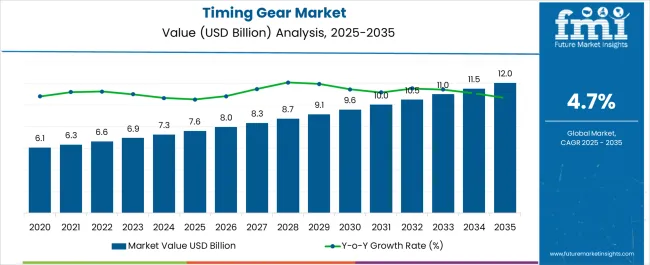
| Metric | Value |
|---|---|
| Timing Gear Market Estimated Value in (2025 E) | USD 7.6 billion |
| Timing Gear Market Forecast Value in (2035 F) | USD 12.0 billion |
| Forecast CAGR (2025 to 2035) | 4.7% |
The timing gear market is experiencing steady expansion, supported by rising production of internal combustion engine vehicles and the continued reliance on precision-engineered powertrain components. Increasing demand for fuel efficiency, better torque management, and optimized combustion processes is driving the adoption of advanced timing gear systems across automotive manufacturing. Technological developments in gear design, including the use of lightweight materials and precision machining, are improving durability, reducing noise, and extending the operational life of engines.
Stringent emission standards in multiple regions are compelling manufacturers to adopt high-performance timing gear solutions that contribute to improved engine efficiency and compliance with regulatory frameworks. Furthermore, the growing penetration of hybrid vehicles, which still require robust engine components, is sustaining long-term demand for timing gears.
Expansion in emerging economies with strong automotive manufacturing bases is also contributing significantly to market growth As the industry transitions towards cleaner mobility solutions, demand for refined, efficient, and durable engine timing components is expected to persist, reinforcing the importance of this market in the broader automotive ecosystem.
The timing gear market is segmented by product type, engine type, vehicle type, sales channel, and geographic regions. By product type, timing gear market is divided into Camshaft Timing Gear and Crankshaft Timing Gear. In terms of engine type, timing gear market is classified into Inline Engines and V - Engines. Based on vehicle type, timing gear market is segmented into Passenger Vehicles, Light Commercial Vehicles, and Heavy Commercial and Off-Highway Vehicles. By sales channel, timing gear market is segmented into OEM and Aftermarket. Regionally, the timing gear industry is classified into North America, Latin America, Western Europe, Eastern Europe, Balkan & Baltic Countries, Russia & Belarus, Central Asia, East Asia, South Asia & Pacific, and the Middle East & Africa.
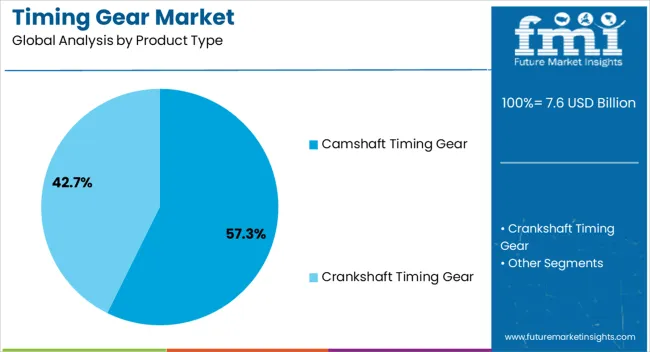
The camshaft timing gear segment is projected to hold 57.3% of the timing gear market revenue share in 2025, making it the dominant product type. This leadership is being driven by its critical role in ensuring precise synchronization between the crankshaft and camshaft, which directly influences valve timing, fuel efficiency, and engine performance. The widespread use of camshaft timing gears across both passenger and commercial vehicles has reinforced their importance in maintaining smooth engine operation and compliance with emission standards.
Continuous innovations in gear manufacturing techniques are enabling higher accuracy and reduced wear, extending the service life of these components. Increasing production of internal combustion engines, especially in markets where electrification is gradual, continues to support strong demand for camshaft timing gears.
Their ability to optimize combustion, reduce noise levels, and contribute to lower fuel consumption has further strengthened their market position As automotive OEMs place greater emphasis on efficiency and regulatory compliance, the camshaft timing gear segment is expected to retain its leadership over the forecast period.
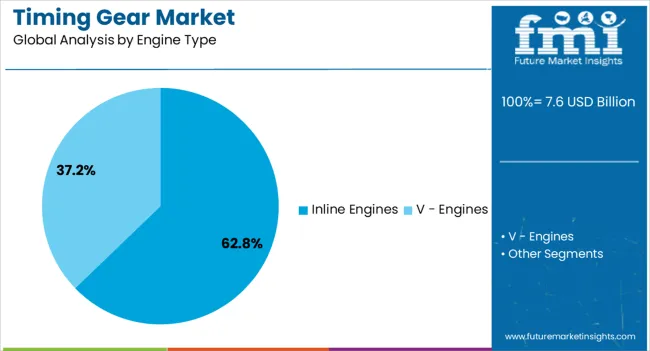
The inline engines segment is expected to account for 62.8% of the timing gear market revenue share in 2025, positioning it as the leading engine type. The dominance of this configuration is being reinforced by its widespread use in both compact and mid-sized vehicles due to design simplicity, cost efficiency, and balanced performance. Inline engines require reliable timing gear systems to ensure precise synchronization of engine components, making them a critical application area for gear manufacturers.
Their relatively compact design allows for efficient integration into a wide range of passenger and light commercial vehicles, which has contributed to their continued popularity. Advancements in manufacturing have improved the strength and efficiency of timing gears used in these engines, reducing maintenance requirements and enhancing durability.
Growing demand for vehicles that deliver fuel efficiency and meet strict emission standards is further increasing reliance on optimized inline engine configurations As this engine type remains the preferred choice for several automakers globally, demand for high-quality timing gear systems within this segment is projected to remain strong.
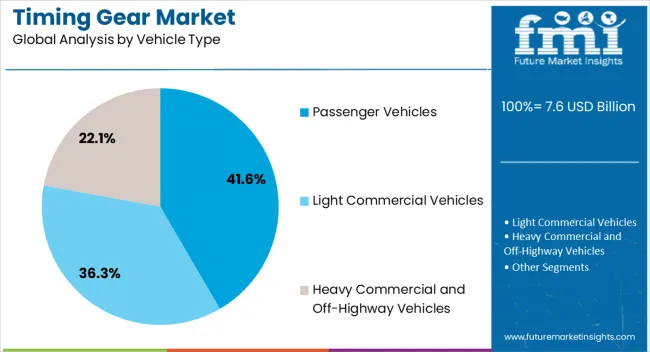
The passenger vehicles segment is anticipated to represent 41.6% of the timing gear market revenue share in 2025, making it the leading vehicle type. This dominance is being driven by rising global demand for passenger cars, particularly in urban regions where personal mobility is increasing. Timing gears are essential in passenger vehicles to ensure precise valve timing, improved combustion, and enhanced engine efficiency, directly impacting driving performance and fuel economy.
Automakers are prioritizing lightweight and durable gear solutions that reduce noise and vibration while extending component lifespan, which is boosting demand within this segment. Regulatory frameworks enforcing strict emission limits are also reinforcing adoption of high-performance timing gears in passenger vehicles to ensure compliance.
The expansion of automotive production in emerging economies and the sustained demand in mature markets are together driving consistent growth in this segment With consumers placing greater emphasis on vehicle reliability, efficiency, and performance, the passenger vehicle segment is expected to continue as the largest end-use sector for timing gears over the coming years.
The market analysis for Timing Gear from 2025 to 2025 exhibited a historical growth rate of 3% CAGR. Timing gears are in high demand due to rising worldwide automotive production and demand for advanced engines, being the primary factors that have driven the market expansion during 2025 - 2025.
According to the most recent FMI analysis, the market is expected to grow at a rate of 4.7% between 2025 and 2035. Stringent emission standards implemented worldwide, such as the latest Euro VI, raise demand for fuel-efficient engines with lower emission levels tend to increase the demand for Timing Gear.
Timing gear size and design differ from engine to engine; for example, timing gear structure differs between an inline engine and a V-cylinder engine. Demand for timing gear is driven by increased vehicle production, replacement, and engine customization. The aftermarket industry includes engine replacement and customization demands. The timing gear is in more demand for new automobiles than it is for replacements.
When timing gear compared with belt technology, the car timing gear reduces friction by 25%. Moreover, the timing gear may outlast the vehicle's full life cycle. The timing gear is more reliable in internal combustion engines than standard belt technology. The goal for increased engine performance and fuel economy drives the demand for timing gear. The timing gear is an important component that contributes to improved automobile performance and speed. As a result, automobile manufacturers choose timing gear over belt technology. The global timing gear market is being propelled forward by the production of light, low-cost, and long-life timing gear.
Government initiatives and new standards are driving automakers all around the world to increase fuel efficiency by lightening vehicles and parts. For example, in Europe and Asia-Pacific, Corporate Average Fuel Economy (CAFÉ) regulations are paving the way for more fuel-efficient vehicles. Improving fuel efficiency by reducing the weight of automotive engines is an important aspect in encouraging the growth of the Timing gear market.
Rising population and income levels will generate additional prospects, propelling the Timing gear market forward over the forecast period.
The introduction of new and advanced technology, such as camless engines, would most certainly hinder the Timing Gear market's growth. Traditionally The timing gear is used to connect the crankshaft at one end and the camshaft at the other. The effective operation of an engine necessitates the appropriate operation of the timing gear, as even a few degrees of lag in the functioning of the Timing gear can impact engine performance. As a result, an engine must be appropriately timed. Hence the introduction of camless engines hinders market growth.
The replacement cost of the timing gear is high, which will increase the maintenance cost of your vehicle, this is the prominent factor impacting the growth of the Timing Gear Market.
In the last Few years, global vehicle production has nearly doubled. The rising production of automobiles around the world drives OEM and aftermarket sales of automotive components. Automotive manufacturing is concentrated in regions like Europe and China.
North America is expected to be the next key market for automobile components such as Timing gears.
The automotive industry is the major manufacturing sector in most countries in the region, such as the United States. Asia-Pacific is another expanding market for timing gears; a current trend in the market is the shift of large players to rising economies for manufacturing, such as China, India, and Korea, among others.
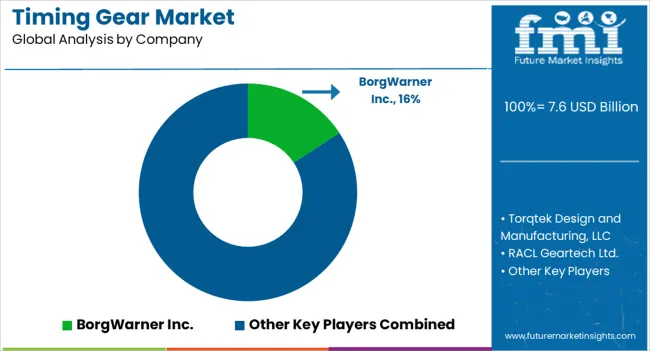
Key players operating in the Timing Gear market are BorgWarner Inc., Torqtek Design and Manufacturing, LLC, RACL Geartech Ltd., W.M. Berg, Bhagat Forge Ltd., Melling Engine Parts, and Jay Bharat Maruti Ltd. Industries.
To build a strong position in the Timing Gear market, key market players are boosting, and expanding sales and distribution networks, product differentiation and new product development, and strategic alliances and partnerships.
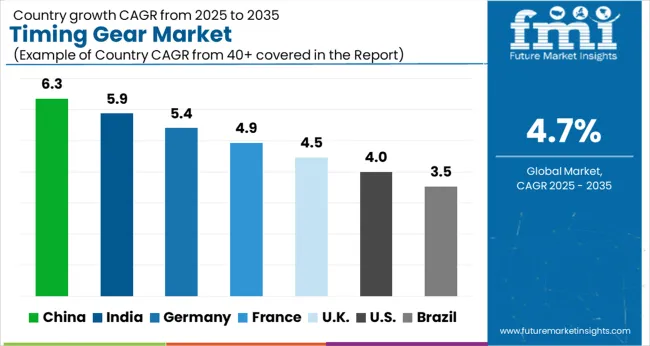
| Country | CAGR |
|---|---|
| China | 6.3% |
| India | 5.9% |
| Germany | 5.4% |
| France | 4.9% |
| UK | 4.5% |
| USA | 4.0% |
| Brazil | 3.5% |
The Timing Gear Market is expected to register a CAGR of 4.7% during the forecast period, exhibiting varied country level momentum. China leads with the highest CAGR of 6.3%, followed by India at 5.9%. Developed markets such as Germany, France, and the UK continue to expand steadily, while the USA is likely to grow at consistent rates. Brazil posts the lowest CAGR at 3.5%, yet still underscores a broadly positive trajectory for the global Timing Gear Market. In 2024, Germany held a dominant revenue in the Western Europe market and is expected to grow with a CAGR of 5.4%. The USA Timing Gear Market is estimated to be valued at USD 2.7 billion in 2025 and is anticipated to reach a valuation of USD 4.0 billion by 2035. Sales are projected to rise at a CAGR of 4.0% over the forecast period between 2025 and 2035. While Japan and South Korea markets are estimated to be valued at USD 371.2 million and USD 213.2 million respectively in 2025.
| Item | Value |
|---|---|
| Quantitative Units | USD 7.6 Billion |
| Product Type | Camshaft Timing Gear and Crankshaft Timing Gear |
| Engine Type | Inline Engines and V - Engines |
| Vehicle Type | Passenger Vehicles, Light Commercial Vehicles, and Heavy Commercial and Off-Highway Vehicles |
| Sales Channel | OEM and Aftermarket |
| Regions Covered | North America, Europe, Asia-Pacific, Latin America, Middle East & Africa |
| Country Covered | United States, Canada, Germany, France, United Kingdom, China, Japan, India, Brazil, South Africa |
| Key Companies Profiled | BorgWarner Inc., Torqtek Design and Manufacturing, LLC, RACL Geartech Ltd., W.M. Berg, Bhagat Forge Ltd., Melling Engine Parts, JBM Industries, Wanxiang America Corporation, SHOWA CORPORATION, Mohit Engineers Pvt. Ltd, JTEKT Corporation, and NTN Corporation |
The global timing gear market is estimated to be valued at USD 7.6 billion in 2025.
The market size for the timing gear market is projected to reach USD 12.0 billion by 2035.
The timing gear market is expected to grow at a 4.7% CAGR between 2025 and 2035.
The key product types in timing gear market are camshaft timing gear and crankshaft timing gear.
In terms of engine type, inline engines segment to command 62.8% share in the timing gear market in 2025.






Our Research Products

The "Full Research Suite" delivers actionable market intel, deep dives on markets or technologies, so clients act faster, cut risk, and unlock growth.

The Leaderboard benchmarks and ranks top vendors, classifying them as Established Leaders, Leading Challengers, or Disruptors & Challengers.

Locates where complements amplify value and substitutes erode it, forecasting net impact by horizon

We deliver granular, decision-grade intel: market sizing, 5-year forecasts, pricing, adoption, usage, revenue, and operational KPIs—plus competitor tracking, regulation, and value chains—across 60 countries broadly.

Spot the shifts before they hit your P&L. We track inflection points, adoption curves, pricing moves, and ecosystem plays to show where demand is heading, why it is changing, and what to do next across high-growth markets and disruptive tech

Real-time reads of user behavior. We track shifting priorities, perceptions of today’s and next-gen services, and provider experience, then pace how fast tech moves from trial to adoption, blending buyer, consumer, and channel inputs with social signals (#WhySwitch, #UX).

Partner with our analyst team to build a custom report designed around your business priorities. From analysing market trends to assessing competitors or crafting bespoke datasets, we tailor insights to your needs.
Supplier Intelligence
Discovery & Profiling
Capacity & Footprint
Performance & Risk
Compliance & Governance
Commercial Readiness
Who Supplies Whom
Scorecards & Shortlists
Playbooks & Docs
Category Intelligence
Definition & Scope
Demand & Use Cases
Cost Drivers
Market Structure
Supply Chain Map
Trade & Policy
Operating Norms
Deliverables
Buyer Intelligence
Account Basics
Spend & Scope
Procurement Model
Vendor Requirements
Terms & Policies
Entry Strategy
Pain Points & Triggers
Outputs
Pricing Analysis
Benchmarks
Trends
Should-Cost
Indexation
Landed Cost
Commercial Terms
Deliverables
Brand Analysis
Positioning & Value Prop
Share & Presence
Customer Evidence
Go-to-Market
Digital & Reputation
Compliance & Trust
KPIs & Gaps
Outputs
Full Research Suite comprises of:
Market outlook & trends analysis
Interviews & case studies
Strategic recommendations
Vendor profiles & capabilities analysis
5-year forecasts
8 regions and 60+ country-level data splits
Market segment data splits
12 months of continuous data updates
DELIVERED AS:
PDF EXCEL ONLINE
Gearbox and Gear Motors Market Size and Share Forecast Outlook 2025 to 2035
Gear Motor Market Size and Share Forecast Outlook 2025 to 2035
Timing Devices Market Analysis - Size, Growth, & Forecast Outlook 2025 to 2035
Gears, Drives and Speed Changers Market Growth – Trends & Forecast 2025 to 2035
Ski Gear & Equipment Market Size and Share Forecast Outlook 2025 to 2035
Ski Gear And Equipment Market Size and Share Forecast Outlook 2025 to 2035
Rail Gearbox Market Size and Share Forecast Outlook 2025 to 2035
Worm Gear Drive Market Size and Share Forecast Outlook 2025 to 2035
Open Gear Lubricants Market
Switchgear for Data Centers Market Size and Share Forecast Outlook 2025 to 2035
Switchgear Market Growth - Trends & Forecast 2025 to 2035
Motor Gear Unit Market
Roller Gear Cam Unit Market Size and Share Forecast Outlook 2025 to 2035
Plastic Gears Market Size and Share Forecast Outlook 2025 to 2035
Bicycle Gear Shifter Market Size and Share Forecast Outlook 2025 to 2035
Advanced Gear Shifter System Market Size and Share Forecast Outlook 2025 to 2035
AC Switchgear Market Size and Share Forecast Outlook 2025 to 2035
DC Switchgear Market - Size, Share, and Forecast 2025 to 2035
External Gear Pump Market Size, Growth, and Forecast 2025 to 2035
Internal Gear Pump Market Size, Growth, and Forecast 2025 to 2035

Thank you!
You will receive an email from our Business Development Manager. Please be sure to check your SPAM/JUNK folder too.
Chat With
MaRIA